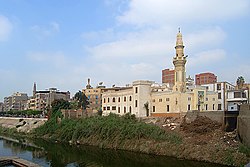City in Gharbia Governorate, Egypt
City in Gharbia, Egypt
Samannud (Arabic : سمنود Samannūd markaz ) located in Gharbia Governorate , Egypt. Known in classical antiquity as Sebennytos (Ancient Greek : Σεβέννυτος ), Samannud is a historic city that has been inhabited since the Ancient Egyptian period. As of 2019, the population of the markaz of Samannud was estimated to be 410,388, with 83,417 people living in urban areas and 326,971 in rural areas.[ 1]
Etymology
The place known in Egyptian Arabic : سمنود [sæmænˈnuːd] Sebennytos or Sebennytus .
The name Samannud ultimately derives from the Ancient Egyptian name ṯb-(n)-nṯr , meaning "city of the sacred calf".[ 7] /ˌcabˈnaːcar/ in Old Egyptian and */ˌcəbˈnuːtə/ or */ˌcəbənˈnuːtə/ in Late Egyptian.[ 8]
Ancient history
Samannud (Sebennytos) was an ancient city of Lower Egypt , located on the now-silted up Sebennytic branch of the Nile in the Delta . Sebennytos was the capital of Lower Egypt's twelfth nome —the Sebennyte nome (district) . Sebennytos was also the seat of the Thirtieth Dynasty of Egypt (380–343 BCE).[ 9] [ 10] [ 11] [ 12]
Sebennytos is perhaps best known as the hometown of Manetho , a historian and chronicler from the Ptolemaic era , c. 3rd century BC. Sebennytos was also the hometown of Nectanebo II ; he was its last ruler.[ 13]
A temple dedicated to the local god Anhur , or Anhur-Shu , and his lioness goddess mate Mehit , once existed at this location but is now reduced to ruins. A fragment from the location where kings would have made offerings to Anhur and his wife, is on display at the Walters Art Museum .[ 14]
Modern history
Samannud violently resisted the Muslim conquest of Egypt in 639, and remained rebellious for some time thereafter; the city revolted four times in the first half of the eighth century. Three Coptic Patriarchs came from Samannud: John III , Cosmas II , and John V . The 12th-century Coptic philologist Yuhanna al-Samannudi also came from Samannud, and served as its bishop.[ 15]
Historical population Year 1996 249,672 — 2006 298,166 +19.4% 2019 410,388 +37.6% Source: Citypopulation.de[ 1]
Samannud's bishopric remained active through the late thirteenth century, indicating the presence of a large Christian population at the time.[ 16]
In 1843, John Gardner Wilkinson described it as a place of some size, with the usual bazaars of the large towns of Egypt, and famous for its pottery, which was sent to Cairo.[ 17]
The 1885 Census of Egypt recorded Samannud as a city in its own district in Gharbia Governorate ; at that time, the population of the city was 11,550 (5,686 men and 5,864 women).[ 18]
Notable people
In religious traditions
In a Coptic tradition, Sebennytos was part of the route of the Holy Family during the flight into Egypt narrated in the Gospel of Matthew (2:13 –23 ).[ 19]
Gallery
Archeological findings from Sebennytos
Sidi Salama minaret
Church of the Holy Virgin and Apanoub
Mitwally minaret
Ghoneim Palace
Ibrahim Sirag el-Din Hammam
Qubba Darihiya
See also
References
^ a b c d "Samannūd (Markaz, Egypt)" . Citypopulation.de . Retrieved 20 June 2020 .^ Wallis Budge, E. A. (1920). An Egyptian hieroglyphic dictionary: with an index of English words, king list and geological list with indexes, list of hieroglyphic characters, coptic and semitic alphabets, etc. Vol II John Murray . p. 1059 . ^ a b c Gauthier, Henri (1929). Dictionnaire des Noms Géographiques Contenus dans les Textes Hiéroglyphiques Vol .6 ^ "أسماء بعض البلاد المصرية بالقبطية - كتاب لغتنا القبطية المصرية | St-Takla.org" . st-takla.org .^ Ptolemy iv. 5. § 50, Stephanus of Byzantium ^ Strabo xvii. p. 802^ Sterling, Gregory E. (1992). Historiography and Self-Definition: Josephos, Luke-Acts, and Apologetic Historiography Brill Publishers . p. 118. ISBN 9004095012 . Retrieved 22 June 2020 . ^ Loprieno, Antonio (1995) Ancient Egyptian: A Linguistic Introduction , Cambridge: Cambridge University Press , ISBN 0-521-44384-9 , p. 34
^ Gray, Leon (2010). The New Cultural Atlas of Egypt . Marshall Cavendish . p. 143. ISBN 9780761478775 ^ Peck, Harry Thurston (1898). Harpers Dictionary of Classical Antiquities (1898) . Harper and Brothers . ^ Smith, William (1858). Dictionary of Greek and Roman Geography . Retrieved 29 March 2020 .^ Cooper, William Ricketts (1876). An Archaic Dictionary: Biographical, Historical, and Mythological: From the Egyptian, Assyrian, and Etruscan Monuments and Papyri S. Bagster and Sons . p. 496. ^ Bill Manley, The Seventy Great Mysteries of Ancient Egypt" Thames & Hudson Ltd, 2003. p.101
^ Watterson, Barbara (2003). Gods of Ancient Egypt History Press . p. 41. ISBN 978-0-7524-9502-6 ^ Sidarus, Adel (2017). "Yuhanna al-Samannudi, the Founder of National Coptic Philology in the Middle Ages". In Gabra, Gawdat; Takla, Hany N. (eds.). Christianity and Monasticism in Northern Egypt: Beni Suef, Giza, Cairo, and the Nile Delta Oxford University Press . pp. 139– 140. ISBN 978-1617977800 . Retrieved 22 June 2020 . ^ Tsuji, Asuka (2017). "The Veneration of Anba Hadid and the Nile Delta in the Thirteenth Century". In Gabra, Gawdat; Takla, Hany N. (eds.). Christianity and Monasticism in Northern Egypt: Beni Suef, Giza, Cairo, and the Nile Delta Oxford University Press . p. 190. ISBN 978-1617977800 . Retrieved 24 June 2020 . ^ Wilkinson, John Gardner (1843). Modern Egypt and Thebes: Being a Description of Egypt, Including the Information Required for Travellers in that Country John Murray . p. 432.^ Egypt min. of finance, census dept (1885). Recensement général de l'Égypte . Retrieved 21 June 2020 . ^ "The Holy Family at Meniet Samanoud" . Tour Egypt . Archived from the original on 12 September 2016. Retrieved 6 November 2016 .
30°58′N 31°15′E / 30.967°N 31.250°E / 30.967; 31.250









